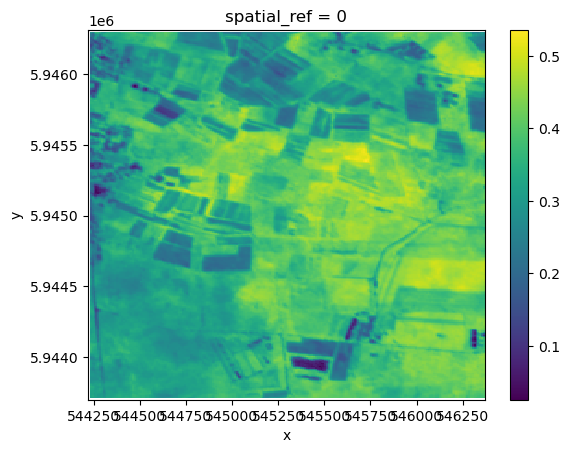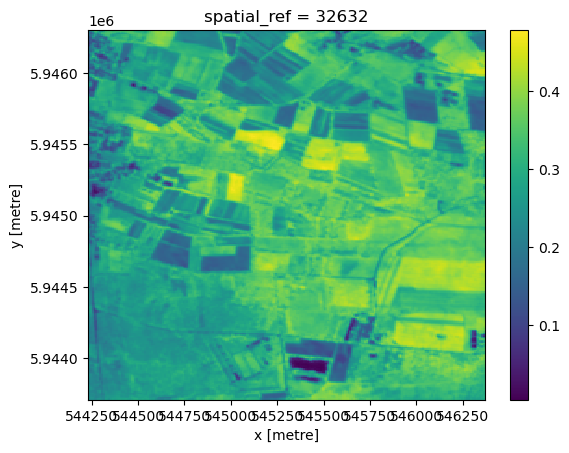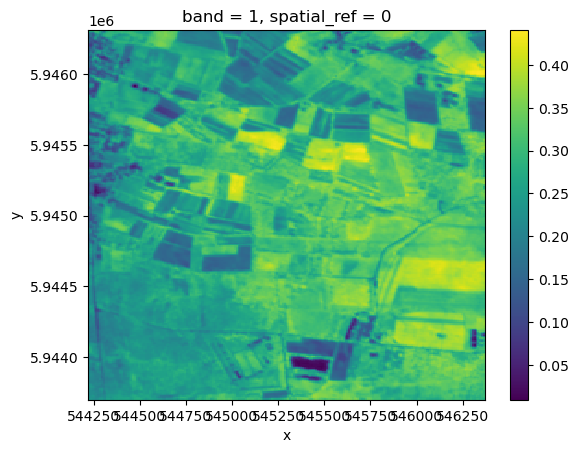EOPF Zarr Data Access with openEO and STAC
Learn how to use the EOPF Zarr data through STAC and openEO

Table of contents¶
Run this notebook interactively with all dependencies pre-installed
Introduction¶
This is a practical introduction to showcasing the interoperability of EOPF Zarr with openEO by accessing and processing EOPF Zarr products via STAC and the openEO API. OpenEO is a unified interface that makes earth observation workflows more standardised, portable, and reproducible.
Setup¶
Start importing the necessary libraries
pip install openeo-processes-dask[implementations]
pip install openeo-pg-parser-networkxfrom openeo.local import LocalConnectionDid not load machine learning processes due to missing dependencies: Install them like this: `pip install openeo-processes-dask[implementations, ml]`
# import openeo # Un-Comment once pull-requests are merged.
import rioxarray as rxr
import dask
from xcube_eopf.utils import reproject_bboxConnect to openEO¶
Connect to an openEO backend.
connection = LocalConnection("./")# Un-Comment once pull-requests are merged and deployed on EODC backend!
# connection_url = "https://openeo.eodc.eu/" # this is throwing an 504 failed to parse error message in the first .download
# connection = openeo.connect(connection_url).authenticate_oidc()Load a virtual data cube¶
First, we’ll define the extents in time and space we are interested in
bbox = [
9.669372670305636,
53.64026948239441,
9.701345402674315,
53.66341039786631,
] # ~250x250 px Northern Germany, Moorrege.
time_range = ["2025-05-01", "2025-06-01"]Define the URL to the STAC resource you want to query. And the band names - they are often specific to the STAC Catalogs used.
stac_url = "https://stac.core.eopf.eodc.eu/collections/sentinel-2-l2a"
bands = ["b02", "b08"] # bandnames are specific to the STAC CatalogsReproject the bbox to the native crs of the STAC items, so that xcube-eopf(which is used under the hood in load_stac()) does not trigger reprojection internally. See detailed behavior here.
crs_reprj = "EPSG:32632"
bbox_reprj = reproject_bbox(bbox, "EPSG:4326", crs_reprj)
spatial_extent_reprj = {
"west": bbox_reprj[0],
"south": bbox_reprj[1],
"east": bbox_reprj[2],
"north": bbox_reprj[3],
"crs": crs_reprj,
}Create a virtual data cube via the funtion load_stac() according to the chosen extents. This also includes the search on the STAC API. Data is not loaded into the working environment here.
cube = connection.load_stac(
url=stac_url,
spatial_extent=spatial_extent_reprj,
temporal_extent=time_range,
bands=bands,
)Inspect the load_stac() process visually.
cubeCreate a processing workflow¶
Apply processing. We’re calculating the NDVI. And getting a monthly mean.
red = cube.band(bands[0])
nir = cube.band(bands[1])
cube_ndvi = (nir - red) / (nir + red)
cube_mnth = cube_ndvi.reduce_dimension(dimension="time", reducer="mean")Inspect the worflow visually.
cube_mnthFinalize the workflow via .execute() for the locally executed openEO version or .download() when connected to an openeo backend. The data is not loaded into the working environment now!
Note: Currently we are using the local processing version of openEO. It is not sending any requests to an actual backend. It is converting the openEO process graph to an executable Python code. It’s interacting only with the STAC API and the data buckets.
Note: .execute() also redoes the STAC API search currently.
res = cube_mnth.execute()
dask.is_dask_collection(res) # check wether data is still lazy.TrueBut we can inspect the dimensionality of the virtual cube.
resProcess and load the data into the working environment.
res = res.compute()
dask.is_dask_collection(
res
) # now the data is loaded, it's not a dask collection anymore.Falseres # the actual values are accessible in the working environment.Plot the map.
res.plot()
Compare to other sources¶
We’ll reuse the process graph we have created and only change the URL to the STAC API to use other sources of input. This is a good example of portability and reproducibility.
def load_ndvi_mean(stac_url, bbox, time_range, bands, time_dim):
cube = connection.load_stac(
url=stac_url,
spatial_extent={
"west": bbox[0],
"south": bbox[1],
"east": bbox[2],
"north": bbox[3],
},
temporal_extent=time_range,
bands=bands,
)
red = cube.band(bands[0])
nir = cube.band(bands[1])
cube_ndvi = (nir - red) / (nir + red)
cube_mnth = cube_ndvi.reduce_dimension(dimension=time_dim, reducer="mean")
return cube_mnthMS Planetary Computer¶
MS Planetary Computer is a stable source of satellite data made available via a STAC API. The Sentinel-2 L2A data has been transformed to Cloud Optimized GeoTiffs (COG) in this collection.
stac_url = "https://planetarycomputer.microsoft.com/api/stac/v1/collections/sentinel-2-l2a" # cog
bands = ["B02", "B08"]
cube_mnth = load_ndvi_mean(stac_url, bbox, time_range, bands, time_dim="time")Finalize the reused workflow via .execute(). The data is not loaded into the working environment yet.
res_mspc = cube_mnth.execute()
dask.is_dask_collection(res_mspc)TrueBut we can inspect the dimensionality of the virtual cube already. The spatial extents are slightly different than what we have received from the EOPF STAC API. This is probably due to the internal reprojection of the bbox. The data is not loaded into the working environment yet.
res_mspcNow we are processing and loading the data into the working enviornment.
res_mspc = res_mspc.compute()
res_mspcres_mspc.plot()
Let’s check the differences of the two results. Note: Differences occur mainly due to the older processing version (2.11) of Sentinel-2 used on MS Planetary Computer.
diff = res - res_mspc
diff.to_series().describe()count 55426.000000
mean 0.055157
std 0.025907
min -0.036408
25% 0.037149
50% 0.054587
75% 0.071017
max 0.172499
dtype: float64CDSE - via openEO¶
Connect to openEO on CDSE. This also authorizes us to request data from the CDSE STAC API.
import openeoconnection_url = "openeo.dataspace.copernicus.eu"
connection = openeo.connect(connection_url).authenticate_oidc()stac_url = (
"https://stac.dataspace.copernicus.eu/v1/collections/sentinel-2-l2a/" # safe format
)
bands = ["B02", "B08"]
cube_mnth = load_ndvi_mean(stac_url, bbox, time_range, bands, time_dim="t")Since we’re connected to the CDSE openEO backend we need to download the result (only JSON can be received via .exectue()). This triggers the processing on the openEO backend as a synchronous call. To register a batch job on the backend and execute it asynchronously use .execute_batch()
res_cdse_backend = cube_mnth.download("res_cdse_backend.tif")And load it into the working environment.
res_cdse_backend = rxr.open_rasterio("res_cdse_backend.tif")Here we get the same extents as from EOPF. By loading via rioxarray the ndvi values are encoded into a band dimension.
res_cdse_backendres_cdse_backend.plot()
Let’s check the differences. Very marginal, likely due to different software used in the different openEO implementations used.
diff2 = res - res_cdse_backend
diff2.to_series().describe()count 55426.000000
mean 0.078158
std 0.023538
min -0.006268
25% 0.062287
50% 0.077005
75% 0.092643
max 0.174986
dtype: float64Takeaway¶
This tutorial has shown how to:
Access EOPF Zarr Data via STAC and openEO
Apply reusable processing workflows via openEO
Compared the EOPF Zarr Data to other available Sentinel-2 sources
